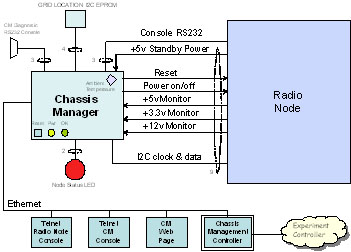Version 1 (CM1)
Table of Contents
The functional block diagram of the Chassis Manager is shown in Figure 1.

The Chassis Manager provides functions to remotely manage an associated Radio Node in the ORBIT grid, or a supporting non-Grid node. The details of the hardware used and the development environment are provided in these sections. The main functions that the CM1 provides (similarly to the future revisions of the CMs) are:
- Issue a NMI system reset to the Radio Node: Upon receiving a “Radio Node Reset” command from the CMC, a local CM drives a signal appropriately to reset the Radio Node.
- Control the system power state of the Radio Node: Upon receiving a “Power On/Off” command from the CMC, a local CM drives a signal appropriately to power up or down the Radio Node. Since the same control line is used both for power on and off, the CM must verify the assumed state of the node before issuing the command.
- Obtain Chassis Status (Voltage, Temperature, and other status): The CM periodically reports node status to the CMC. This status message includes voltages, temperature, and other tbd parameters.
- Provide a pass-through Telnet session Radio Node: The CM provides a “pass-through” Telnet session to the serial console of the Radio Node Host. A workstation can create this connection by starting a telnet session to the IP address of the CM using port 3025. The Host serial port baud rate is stored in the NodeID box, and has the default value 115200 baud.
- Provide CM diagnostics: There are several diagnostic commands designed for integration and test. These include:
- Remotely identify a CM from the CMC: An “Identify” command issued from the CMC causes the CM to blink a local highly-visible “Identify LED” twice/second for approximately a 20 second period.
- Identify a node at the CMC from the CM: A momentary contact button on the Grid Node Chassis generates an IDENTIFY message to the CMC. The CMC then blinks the Identify LED at a high rate for approximately two seconds. This assists in physical verification of node placement and a quick test of end-to-end connectivity with the CMC.
- Provide a Telnet session to the CM console: The CM provides a “pass-through” Telnet session to the serial console of the CM. A device can create this connection by starting a telnet session to the IP address of the CM using port 23. The Telnet session and the directly RS232 connected 57600 baud console session provides a menu driven interface to control CM functions. A sample of the menu driven CM console session is shown in Figure 2.
- Provide a means to reset (reboot) the CM (both locally and remotely): The CM accepts a reset command from a momentary contact push button switch on the CM, a push button switch on the NodeID box, or from a “console” session directly connected or through a telnet session.
- Provide a means to locally interrogate the Grid Position of the node: The identity of the CM is determined by reading the “grid position” from the NodeID box EEPROM. This “grid position” is the either the x,y coordinate of the node, or the ID number of a non-Grid node. The “grid position” is used to create the static IP address of the CM.. The static IP address space of the ORBIT system is defined in Table 1 below.
| Static IP Address | Component |
| 10.1.—-.—- | CM Grid and non-Grid components |
| 10.1.x.y | Main grid coordinate (x,y) |
| 10.1.100+N,x|y | Sandbox Grid N and coordinate (x,y) |
| 10.1.100.y | Support Grid node y |
| 10.1.200.1 | Chassis Manager Controller |
| 10.1.222.222 | Error default CM address |
Table 1: Orbit Static IP Address Space
- Provide local visual indication of node operational status: The CM provides an indicator that the CM is running (a slowly blinking LED).
- Provide a control API to the Experiment Controller: The EC and CMC implement a management communications protocol to exchange command and status information. This protocol is defined later in this document.
All commands processed by the Chassis Manager Controller generate a reply message to indicate weather the command was executed successfully or not.
Last modified
13 years ago
Last modified on Jan 11, 2013, 5:09:17 PM
Attachments (1)
Note:
See TracWiki
for help on using the wiki.
